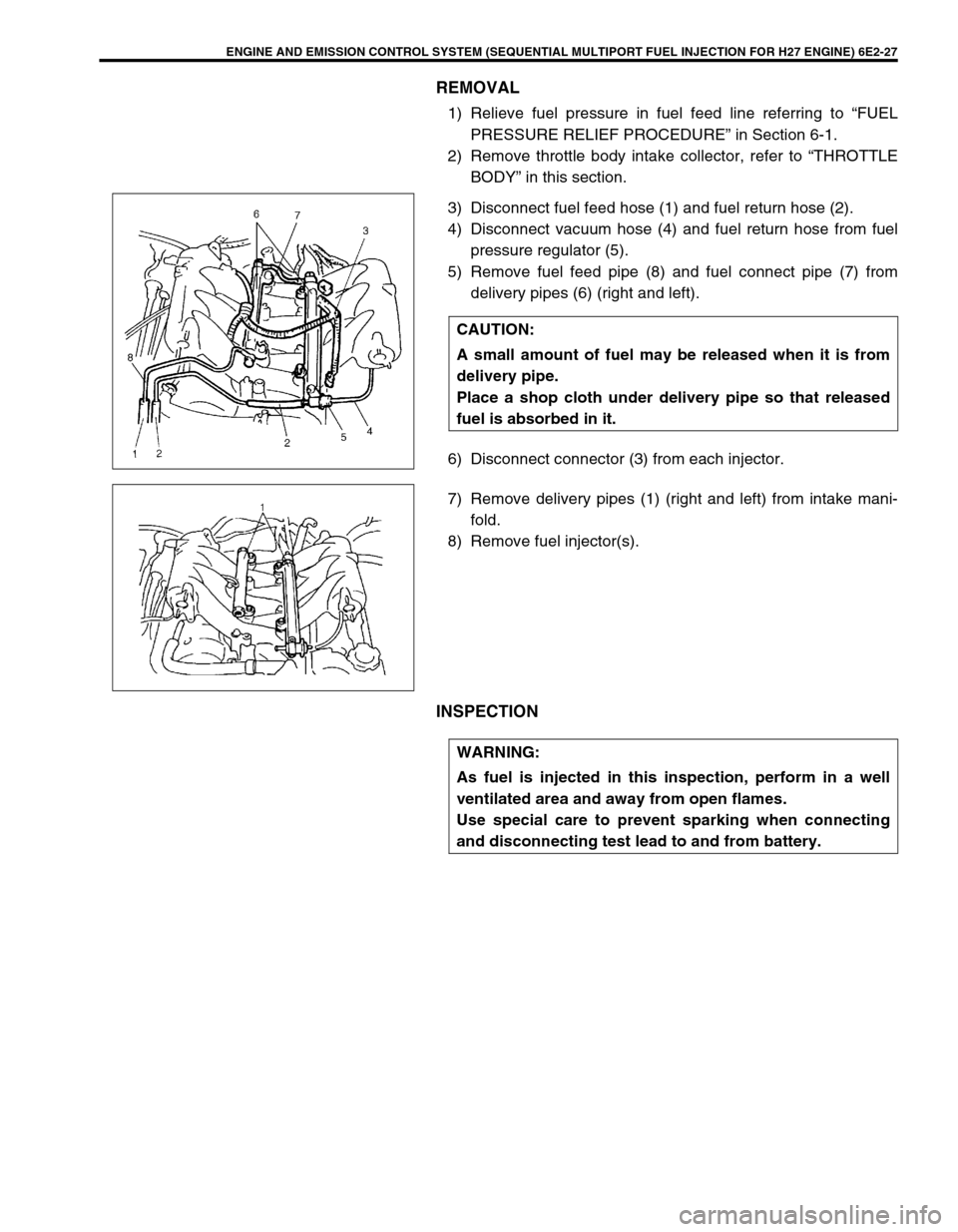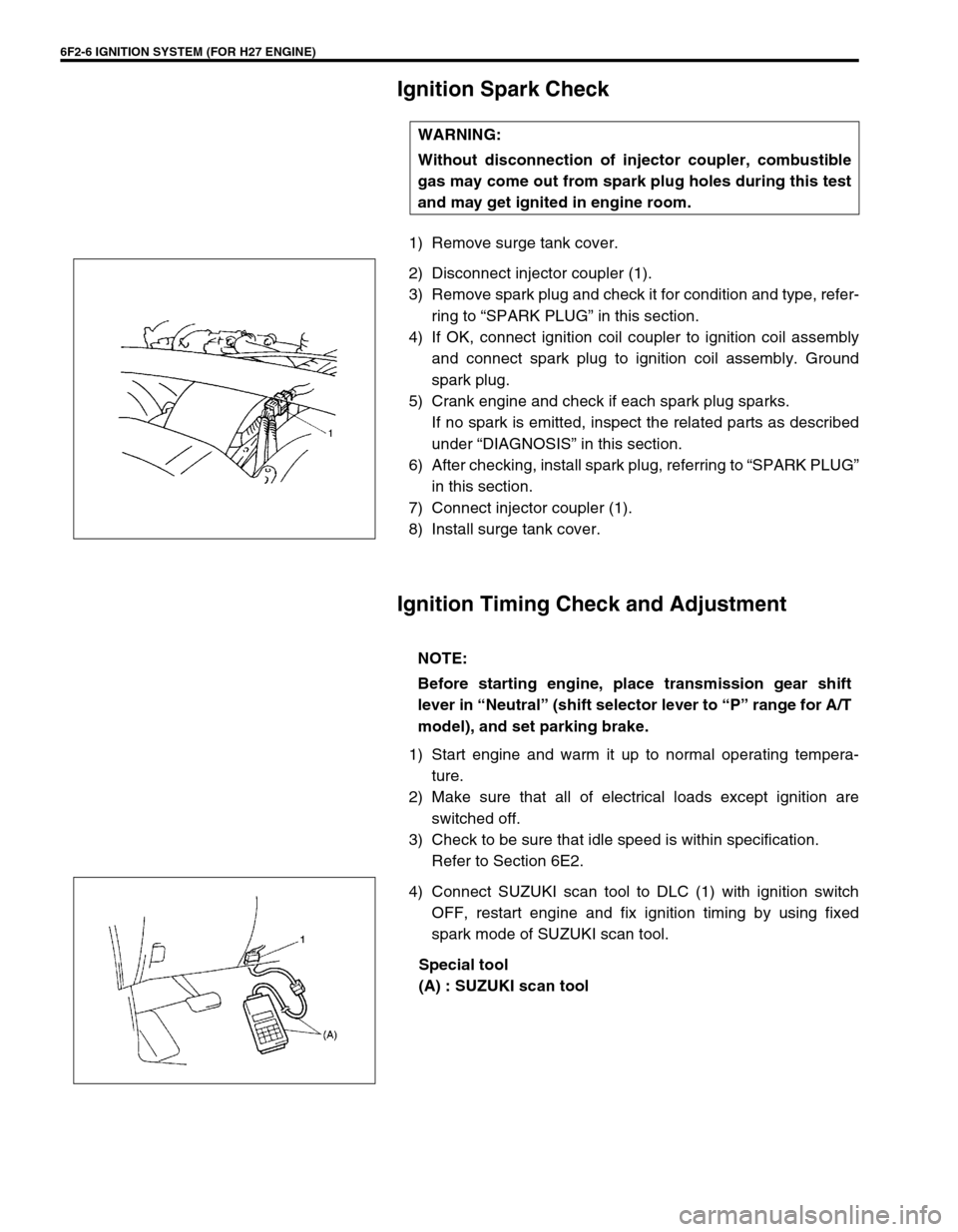1999 SUZUKI GRAND VITARA spark
[x] Cancel search: sparkPage 242 of 656

ENGINE GENERAL INFORMATION AND DIAGNOSIS (H27 ENGINE) 6-1-81
TROUBLESHOOTING
Step Action Yes No
1 Was “ENGINE DIAG. FLOW TABLE” per-
formed?Go to Step 2. Go to “ENGINE DIAG.
FLOW TABLE” in this
section.
2 Ignition system inspection :
1) Check spark plug and ignition spark of cylin-
der where misfire occurs, referring to “IGNI-
TION SYSTEM” section.
Is it in good condition?Go to Step 3. Faulty ignition coil, wire
harness, or other system
parts.
3 Fuel injector circuit inspection :
1) Using sound scope, check each injector
operating sound at engine cranking or
idling.
Do all injectors make operating sound?Go to Step 4. Check coupler connec-
tion and wire harness of
injector not making oper-
ating sound and injector
itself.
If OK, substitute a known-
good ECM (PCM) and
recheck.
4 Fuel pressure inspection :
1) Check fuel pressure referring to “TABLE B-
3” in this section.
Is check result satisfactory?Go to Step 5. Repair or replace.
5 Fuel injector inspection :
1) Check fuel injector(s) referring to Section
6E2.
Is check result satisfactory?Go to Step 6. Replace.
6 Ignition timing inspection :
1) Check ignition timing referring to Section
6F2.
Is check result satisfactory?Go to Step 7. Adjust or check system
related parts.
7 EGR system inspection :
1) Check EGR system referring to Section
6E2.
Is check result satisfactory?Go to Step 8. Repair or replace.
8 Fuel level sensor inspection :
1) Check fuel level sensor referring to Section
6E2.
Is check result satisfactory?Go to Step 9. Repair or replace.
9 Check engine mechanical parts or system
which can cause engine rough idle or poor per-
formance.
• Engine compression (See Section 6A2).
• Valve lash or lash adjuster (See Section
6A2).
• Valve timing (Timing belt or chain installa-
tion. See Section 6A2).
Are they in good condition?Check wire harness and
connection of ECM (PCM)
ground, ignition system
and fuel injector for inter-
mittent open and short.Repair or replace.
Page 360 of 656

ENGINE AND EMISSION CONTROL SYSTEM (SEQUENTIAL MULTIPORT FUEL INJECTION FOR H27 ENGINE) 6E2-27
REMOVAL
1) Relieve fuel pressure in fuel feed line referring to “FUEL
PRESSURE RELIEF PROCEDURE” in Section 6-1.
2) Remove throttle body intake collector, refer to “THROTTLE
BODY” in this section.
3) Disconnect fuel feed hose (1) and fuel return hose (2).
4) Disconnect vacuum hose (4) and fuel return hose from fuel
pressure regulator (5).
5) Remove fuel feed pipe (8) and fuel connect pipe (7) from
delivery pipes (6) (right and left).
6) Disconnect connector (3) from each injector.
7) Remove delivery pipes (1) (right and left) from intake mani-
fold.
8) Remove fuel injector(s).
INSPECTION
CAUTION:
A small amount of fuel may be released when it is from
delivery pipe.
Place a shop cloth under delivery pipe so that released
fuel is absorbed in it.
WARNING:
As fuel is injected in this inspection, perform in a well
ventilated area and away from open flames.
Use special care to prevent sparking when connecting
and disconnecting test lead to and from battery.
Page 384 of 656

IGNITION SYSTEM (FOR H27 ENGINE) 6F2-1
6F2
SECTION 6F2
IGNITION SYSTEM (FOR H27 ENGINE)
CONTENTS
General Description ...................................... 6F2-2
Components ................................................ 6F2-2
System Wiring ............................................. 6F2-3
Diagnosis ....................................................... 6F2-4
Diagnostic Flow Table ................................. 6F2-4
Ignition Spark Check ................................... 6F2-6
Ignition Timing Check and Adjustment........ 6F2-6On-Vehicle Service ....................................... 6F2-8
Ignition Coil Assembly (Igniter and Ignition
Coil)............................................................. 6F2-8
Spark Plug .................................................. 6F2-8
CMP Sensor.............................................. 6F2-10
Noise Suppressor ..................................... 6F2-12
Special Tool ................................................. 6F2-13
WARNING:
For vehicles equipped with Supplemental Restraint (Air Bag) System:
Service on and around the air bag system components or wiring must be performed only by an
authorized SUZUKI dealer. Refer to “Air Bag System Components and Wiring Location View” under
“General Description” in air bag system section in order to confirm whether you are performing ser-
vice on or near the air bag system components or wiring. Please observe all WARNINGS and “Ser-
vice Precautions” under “On-Vehicle Service” in air bag system section before performing service
on or around the air bag system components or wiring. Failure to follow WARNINGS could result in
unintentional activation of the system or could render the system inoperative. Either of these two
conditions may result in severe injury.
Technical service work must be started at least 90 seconds after the ignition switch is turned to the
“LOCK” position and the negative cable is disconnected from the battery. Otherwise, the system
may be activated by reserve energy in the Sensing and Diagnostic Module (SDM).
Page 385 of 656

6F2-2 IGNITION SYSTEM (FOR H27 ENGINE)
General Description
The ignition system is a direct ignition system. It consists of the parts as described below and has an electronic
ignition control system.
•ECM (or PCM)
It detects the engine condition through the signals from the sensors, determines the most suitable ignition
timing and time for electricity to flow to the primary coil and sends a signal to the igniter (in ignition coil
assembly).
•Ignition coil assembly (including an igniter and an ignition coil)
The ignition coil assembly has a built-in igniter and ignition coil which turns ON and OFF the primary current
of the ignition coil according to the signal from ECM (or PCM). When the ignition coil primary current is
turned OFF, a high voltage is induced in the secondary wiring. One ignition coil is in charge of ignition of one
cylinder only.
•Spark plug and noise suppressor
•CMP sensor, TP sensor, ECT sensor, IAT sensor, VSS, knock sensor and MAF sensor
For their details, refer to Section 6E2.
This ignition system does not have a distributor and high-tension cords but each cylinder has an ignition coil
assembly (igniter and ignition coil) and the secondary voltage which occurred in the ignition coil is sent to the
spark plug directly. Also, the signal(s) are sent from the CMP sensor to ECM (or PCM) so as to control each igni-
tion coil independently through the igniter (in ignition coil assembly).
Components
NOTE:
For other components not found in this figure, refer to Section 6E2.
1. Ignition coil assembly (igniter and ignition coil)
2. CMP sensor
3. Noise suppressor
4. ECM (or PCM)
5. Spark plug
Page 386 of 656

IGNITION SYSTEM (FOR H27 ENGINE) 6F2-3
System Wiring
NOTE:
For ECM (PCM) terminal assignment, refer to Section 6E2.
1. To ignition switch 8. Ignition coil assembly (For No.3 cylinder)
2.“IG COIL METER” fuse 9. Ignition coil assembly (For No.4 cylinder)
3. ECM (or PCM) 10. Spark plug
4. CMP sensor 11. Ignition coil assembly (For No.5 cylinder)
5. Noise suppressor 12. Ignition coil assembly (For No.6 cylinder)
6. Ignition coil assembly (For No.1 cylinder) 13. To main relay
7. Ignition coil assembly (For No.2 cylinder) 14. Sensed information
Page 387 of 656

6F2-4 IGNITION SYSTEM (FOR H27 ENGINE)
Diagnosis
Diagnostic Flow Table
Condition Possible Cause Correction
Engine cranks, but will
not start or hard to
start (No spark)Blown fuse for ignition coil assembly Replace.
Loose connection or disconnection of lead wire Connect securely.
Faulty spark plug (s) Replace.
Faulty ignition coil assembly (s) Replace.
Faulty CMP sensor Replace.
Faulty ECM (or PCM) Replace.
Maladjusted ignition timing Adjust.
Poor fuel economy or
engine performanceIncorrect ignition timing Adjust.
Faulty spark plug(s) Replace.
Faulty ignition coil assembly (s) Replace.
Faulty CMP sensor Replace.
Faulty ECM (or PCM) Replace.
Faulty knock sensor Replace.
Step Action Yes No
1Was “ENGINE DIAGNOSTIC FLOW TABLE” in
Section 6-1 performed?Go to Step 2. Go to “ENGINE DIAG-
NOSTIC FLOW TABLE” in
Section 6-1.
2 Ignition Spark Test
1) Check all spark plug for condition and type,
referring to “SPARK PLUG” in this section.
2) If OK, perform ignition spark test, referring
to “IGNITION SPARK CHECK” in this sec-
tion.
Is spark emitted from all spark plugs?Go to Step 8. Go to Step 3.
3 Diagnostic Trouble Code (DTC) Check
1) Check DTC stored in ECM (or PCM), refer-
ring to “DIAGNOSTIC TROUBLE CODE
(DTC) CHECK” in Section 6E2.
Is DTC stored?Go to applicable flow table
corresponding to that
code No. in Section 6E2.Go to Step 4.
4 Electrical Connection Check
1) Check ignition coil assemblies for electrical
connection.
Are they connected securely?Go to Step 5. Connect securely.
5 Ignition Coil Assembly Power Supply, Ground
and Trigger Signal Circuits Check
1) Check these circuits for open and short.
Are circuits in good condition?Go to Step 6. Repair or replace.
6 Ignition Coil Assembly Check
1) Substitute a known-good ignition coil
assembly and then repeat Step 2.
Is check result of Step 2 satisfactory?Malfunction of ignition coil
assembly.Go to Step 7.
Page 389 of 656

6F2-6 IGNITION SYSTEM (FOR H27 ENGINE)
Ignition Spark Check
1) Remove surge tank cover.
2) Disconnect injector coupler (1).
3) Remove spark plug and check it for condition and type, refer-
ring to “SPARK PLUG” in this section.
4) If OK, connect ignition coil coupler to ignition coil assembly
and connect spark plug to ignition coil assembly. Ground
spark plug.
5) Crank engine and check if each spark plug sparks.
If no spark is emitted, inspect the related parts as described
under “DIAGNOSIS” in this section.
6) After checking, install spark plug, referring to “SPARK PLUG”
in this section.
7) Connect injector coupler (1).
8) Install surge tank cover.
Ignition Timing Check and Adjustment
1) Start engine and warm it up to normal operating tempera-
ture.
2) Make sure that all of electrical loads except ignition are
switched off.
3) Check to be sure that idle speed is within specification.
Refer to Section 6E2.
4) Connect SUZUKI scan tool to DLC (1) with ignition switch
OFF, restart engine and fix ignition timing by using fixed
spark mode of SUZUKI scan tool.
Special tool
(A) : SUZUKI scan tool WARNING:
Without disconnection of injector coupler, combustible
gas may come out from spark plug holes during this test
and may get ignited in engine room.
NOTE:
Before starting engine, place transmission gear shift
lever in “Neutral” (shift selector lever to “P” range for A/T
model), and set parking brake.
Page 390 of 656

IGNITION SYSTEM (FOR H27 ENGINE) 6F2-7
5) Set timing light to ignition harness for No.1 cylinder.
6) Using timing light, check that timing observed from viewpoint
is within specification.
Initial ignition timing of viewpoint
(when it is fixed by SUZUKI scan tool) :
5 ± 1° BTDC
Ignition order :
1-6-5-4-3-2
Special tool
(A) : 09930-76420
7) If ignition timing is out of specification, loosen flange bolt,
adjust timing by turning CMP sensor (1) while engine is run-
ning, and then tighten bolt (2).
Tightening torque
CMP sensor bolt (a) : 15 N·m (1.5 kg-m, 11.0 lb-ft)
8) After tightening bolt (2), recheck that ignition timing is within
specification.
9) After checking and/or adjusting, end fixed spark mode of
SUZUKI scan tool.
10) With engine idling (closed throttle position and vehicle
stopped), check that ignition timing is about BTDC 12-16°
(shown in the figure). Also, check that increasing engine
speed advances ignition timing.
If above check results are not satisfactory, check input sig-
nals related to this system.
1. Timing mark on crankshaft pulley
NOTE:
In this state, ignition timing may vary more or less of ini-
tial ignition timing but it is nothing abnormal.
1. Timing mark on crankshaft pulley